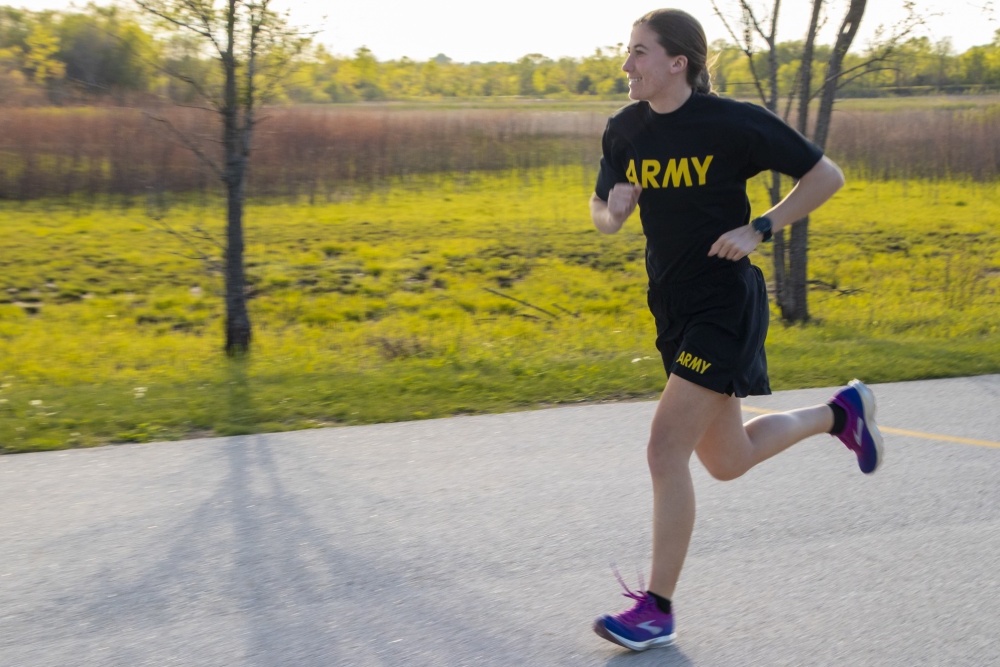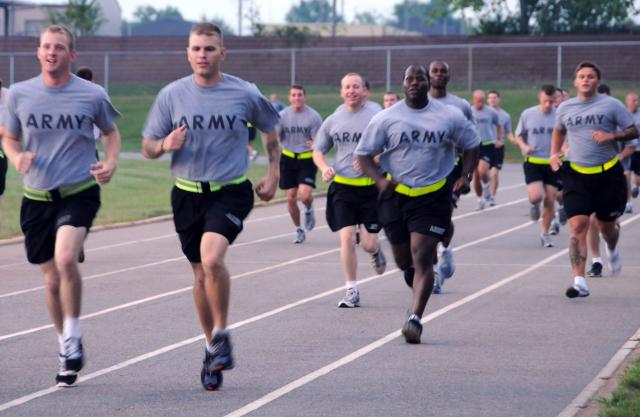12-Week ACFT Train-Up Plan on TrainHeroic!
Hey, before you go any further, if you’re someone that needs help, I got you. My ACFT Train-Up Plan is now only $75. If you’re looking for an ACFT specific train-up program to follow, to get coaching, feedback, questions answered, exercise modifications as needed and to train virally with others I got you. Plus I have been training soldiers for over a decade and have way more than a weekend cert.
I wrote a 2-part blog a couple years back on How to Improve Your APFT Score and part 1 was geared toward the 2-Mile run, so if you wanted to just go read that’s cool. I could’ve just copy and pasted it in here and taken the easy way out, but I figured I’d write an entirely new blog because people hate reading and I like spending my time putting stuff out that 6 people read. I’m kidding, it’s at least 20. But for the sake of beating a dead horse, I’ll keep this short and to the point.
Well we finally made it to the last event of the Army Combat Fitness Test (ACFT), the 2-Mile Run and my final blog on the ACFT Events. The great thing is this is going to be quick thanks to the US Army. I can’t make this shit up. 6 events for the ACFT, 5 of which have 3 exercises that they suggest can help you in your training for that specific event. And guess what the 3 are for the 2-Mile Run? Nothing. That’s right people, per the ACFT website, the Army doesn’t have any training suggestions for the 2-Mile Run. So either they don’t want you to train for it, someone fucked up and forgot to put them on it or they just want you to run 2 miles over and over again. Honestly, I’m disappointed that they don’t have ANY suggestions. This event is the lowest hanging fruit of them all when it comes to training for it and yet they just decide to phone it in and not give you any help. Outside of the Hand Release Push-Up Event, this is the only other one that doesn’t require any equipment.
Okay, I stand corrected, the Army does have some suggestions. Now granted they don’t have any suggestions on the ACFT website, they are hidden within the ACFT Handbook, but I was able to find some suggestions (see below). Not too bad. I like the intervals (30:60s, 60:120s) and the hill repeats that they have if they are run properly. I don’t think the 300m Shuttle will help your 2-Mile Run too much, but it’ll help on that Sprint-Drag-Carry so that’s a good thing. As for all the other runs listed, if there is a plan and a goal then they could be good, but if there isn’t a plan besides just “go for a unit run” it’s most likely not going to help. Have no fear GPS is here. I’m going to keep this one short and sweet for you and I’ll even include an 8-Week 2-Day (+1-Day Optional) running program for you at the end. Why? Because I care.
In my time working with Tactical Athletes I have found there are 3-types of runners. There are those that love it, those that hate it, and those that tolerate it. But, with having to get through 5 events before the 2-Mile I have a feeling that everyone will be in the “hate it” category on ACFT day. For those of you that have taken an ACFT you already know how shitty your legs can feel by the time you make it to the run. The good thing being, if you are a strong runner, the other events shouldn’t have too much of a carry-over effect, but if you aren’t a good runner, well you are in for a world of suck. The Sprint-Drag-Carry alone will turn your legs to cement. So don’t expect to set any personal bests on your 2-Mile in your first ACFT.
For the vast majority of you reading this, Long Slow Distance (LSD) training has been a mainstay of your weekly unit running program. Rarely have I come across soldiers who are used to performing intervals/speed work to better develop their speed endurance to decrease their 2-Mile Run time. If you want to be fast you have to train fast, no ifs, ands or buts about it. This means you actually have to run shorter distances at near maximum speed and be able to repeat it over and over again for weeks on end. LSD isn’t the devil, it just isn’t the best option for what you have to do.
Put the Long Slow Distance running on the back burner…I feel the need, the need for SPEED!
So unless you are someone that is brand new to running, LSD training isn’t going to help you run the 2-Mile any faster. If you’re someone that is at the mercy of unit PT, may the PT Gods have mercy on your soul…and your back and knees. I’m kidding, but you’ll need to help yourself first. Casually drop hints about learning about a different way to increase everyone’s speed from this amazing website that is dedicated to training soldiers. Wink wink. Maybe even tell them you came up with this great, semi-customizable training program that will work for everyone. Hell, it’s worth a shot and maybe you’ll be able to get more out of unit PT. When all else fails, just slam your BANG energy and take off down Ardennes.
If you have control of your PT and you are someone that needs to get faster, put all those 5+ mile runs on the back burner for now, we got some speed work to do. In my blog on the APFT, I wrote, “The only time I would recommend longer distances when training someone up for a 2 mile is if they are so deconditioned that they need to get more volume in to build an aerobic base.” I still stand by that. You’ve all logged a bunch of miles and I’ve helped 100’s of experienced runners get faster. So if you fall into that camp, you’re in luck.
If you’re a novice, this program will work for you as well. Getting a novice better at something is fairly easy and is how a lot of inexperienced coaches out there make a living. Barring them getting hurt, as long as they show up and start doing something regularly they will get better. I bet if you took someone who has never run a 2-Mile and made them run one, then made them run another one in 6 days, they’d run the second one faster. Welcome to being a novice and hitting a PR every week. Ahhhh, those were the days. This isn’t a shot at anyone it’s more a PSA to do a little bit of research on the source before you jump into something.
But don’t worry, I’ve helped tons of soldiers with or without running experience get faster, and I know this program works because it’s worked for 100’s of soldiers as well as worked for me. Before we get to the running program. Let’s talk about warming up. Dynamically warming-up is a cornerstone of any sound performance program and is the reason I talk about it at nauseam. This is often the most skipped part of any training session but is the one part that can substantially reduce the likelihood of injuries. If you don’t know what to do just watch the video. I’d really like to get this bad boy to 100k views!
If you didn’t see the pop-up to get the 8-Week ACFT 2-Mile Training Plan, shoot me an email and I’ll send it to you, gpshumanperformance@gmail.com
The Alternate Aerobic Events:
Maybe (probably won’t) I’ll write a separate blog on the Alternate Aerobic Events at some point, but until then here is what the Army has for you. The alternate assessment will include all ACFT events within the limits of the Soldier’s profile, and must include at a minimum: three-Repetition Maximum Deadlift, Sprint-Drag-Carry, and one of the four aerobic events: two-mile run, 15,000 meter stationary bike, 5,000 meter row, or 1,000 meter swim. The time standard for each aerobic event is 25 minutes. Soldiers with permanent profiles must at a minimum achieve the “GOLD” level for the 3-Repetition Maximum Deadlift, the Sprint-Drag-Carry and the aerobic event to pass. Needless to say, good luck if you’re on profile and have to do any of these. They are doable, but damn they are going to be tough, especially if you are on profile. If you are bored, there are some good YouTube comments on them hahaha.
If you want to take all the guesswork out of your daily training regiment, or if you’re looking for an ACFT Train-Up plan to follow, the easiest and smartest thing you can do is join one of our Online Training Teams for less than a $1 a day or buy access to our 12-Week ACFT Train-Up Plan. We have something for everyone, Tactical, Daily or Weightlifting Teams. Learn more at the link below.
Need Help? Just ask…Seriously.
I hope this can help some of you out there. If you have questions let me know geoff@gpshumanperformance.com
Geoffrey Steinbacher is a former Strength & Conditioning Coach within the THOR3 (Tactical Human Optimization Rapid Rehabilitation & Reconditioning) Program at Ft. Bragg. He is a Certified Strength and Conditioning Specialist (CSCS) from the National Strength and Conditioning Association, as well as a Certified Athletic Trainer (ATC) from the National Athletic Trainers Association. He is also an Advanced Sports Performance Coach (USAW-L2) and Head Club Coach with USA-Weightlifting, and a Catalyst Athletics Certified Weightlifting Coach (CACWC-L1). Furthermore, Geoff has a BS in Athletic Training from SUNY Cortland and an MS in Exercise Science from Syracuse University.
ACFT Handbook Description/Standards Below:
2 Mile Run (2MR) – is a test of aerobic endurance. It applies to common Soldier tasks such as dismounted movement, ruck marching, and infiltration. It can be completed on an indoor or outdoor track, or an improved surface such as a road or sidewalk. The 2MR cannot be tested on unimproved terrain. There is a programmed 5-minute rest between the LTK and the 2MR. The rest period begins when the last Soldier in the group completes the LTK. The start and finish line will be near the same location as the test site for the other 5 test events. Out-and-back or lap track courses are authorized. Separate 2MR graders are authorized. When using separate graders, the OIC or NCOIC is responsible for the orderly transfer of the scorecards from the lane graders to the 2MR graders.
Grader Tips:
- The OIC/NCOIC will ensure the 2MR course is measured to standard for distance and elevation and is clear from obstructions and debris.
- An additional set of 2MR graders will increase throughput and reduce overall testing time. When a group of Soldiers completes the Leg Tuck, the NCOIC will facilitate the transfer of Soldiers and scorecards to the 2MR NCOIC. The 2MR NCOIC will ensure Soldiers receive a minimum of 5 minutes between the end of the LTK and the beginning the 2MR.
- An out and back 2MR course may reduce number of 2MR graders required to effectively monitor large groups of Soldiers.





2 thoughts on “Tactical Training: The ACFT 2-Mile Run”
Thanks
You’re very welcome!